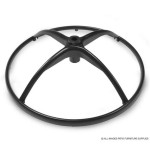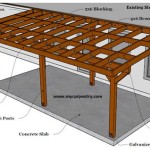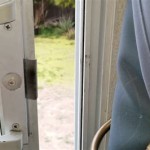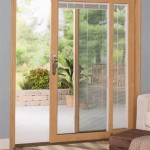Sliding Patio Screen Door Track Repair: A Comprehensive Guide
Sliding patio screen doors offer a seamless transition between indoor and outdoor spaces, providing ventilation while keeping insects at bay. However, these doors rely on a smooth-functioning track system, and when that track becomes damaged or worn, the door's operation can be severely compromised. Understanding the causes of track damage and the methods for repair is crucial for maintaining the functionality and longevity of a sliding patio screen door. This article will explore common track issues, provide detailed repair instructions, and highlight preventative measures to ensure optimal performance.
The track system of a sliding patio screen door is typically composed of aluminum or vinyl, materials chosen for their durability and resistance to the elements. Despite their robustness, these tracks are subject to constant friction from the door rollers, exposure to dirt and debris, and potential physical impact. Over time, these factors contribute to wear and tear, leading to problems that hinder the door's smooth operation. Common issues include dents, bends, corrosion, and the accumulation of debris within the track groove. Addressing these problems promptly prevents further damage and extends the life of the door.
Identifying Common Sliding Patio Screen Door Track Problems
Before embarking on any repair work, accurately diagnosing the specific issue affecting the sliding patio screen door track is essential. This involves a thorough inspection of the track system to identify any visible damage or obstructions. Common problems include:
Debris Accumulation: This is perhaps the most frequent cause of a sticking or difficult-to-move screen door. Leaves, dirt, sand, and insect debris can accumulate within the track groove, creating friction and impeding the rollers' smooth movement. This buildup often manifests as a gritty or resistant feeling when attempting to open or close the door.
Bent or Dented Tracks: Physical impact from pets, children, or even accidental bumps can cause the track to bend or dent. These deformities create obstructions that prevent the rollers from gliding smoothly along the track. Even minor bends can significantly impact the door's operation. Look closely at the track's surface, especially near the bottom where impacts are most common. Use a straight edge to check for any deviations from a smooth, even plane.
Corrosion: In coastal areas or areas with high humidity, corrosion can be a significant problem, especially for aluminum tracks. The corrosion process weakens the metal, creating a rough, pitted surface that impedes roller movement and can eventually lead to structural failure of the track. Visually inspect the track for signs of discoloration, rust, or pitting.
Worn-Out Tracks: Constant friction from the door rollers can gradually wear down the track surface, creating grooves or indentations. This wear is most noticeable in areas where the rollers frequently travel. Examine the track for any signs of excessive wear or grooves, which can indicate the need for repair or replacement.
Damaged Rollers: While not strictly a track problem, damaged or worn rollers can contribute to track damage and impede smooth operation. Rollers that are flattened, cracked, or seized up will drag along the track instead of rolling, causing increased friction and potentially damaging the track surface. Inspect the rollers for any signs of wear or damage.
By carefully examining the track and identifying the specific problem, a targeted repair strategy can be developed, maximizing the effectiveness of the repair efforts.
Steps for Repairing a Sliding Patio Screen Door Track
Once the problem has been identified, the appropriate repair method can be implemented. The following steps outline common repair procedures for addressing various track issues:
Cleaning the Track: This should be the first step in any repair process, regardless of the severity of the perceived problem. Often, simply removing accumulated debris can significantly improve the door's operation.
1. Gather Supplies: Collect a stiff-bristled brush (a toothbrush or small scrub brush works well), a vacuum cleaner with a hose attachment, a damp cloth, and a mild detergent (dish soap is usually sufficient).
2. Remove Loose Debris: Use the brush to loosen any dirt, leaves, or other debris that is lodged within the track groove.
3. Vacuum the Track: Use the vacuum cleaner with the hose attachment to thoroughly remove all the loosened debris from the track.
4. Wash the Track: Mix a small amount of mild detergent with water. Use a damp cloth to wipe down the track, removing any remaining dirt or grime. Avoid using excessive water, as this could lead to corrosion.
5. Dry the Track: Use a clean, dry cloth to thoroughly dry the track. Ensure no moisture remains that could contribute to corrosion or attract more debris.
6. Lubricate the Track: Apply a silicone-based lubricant to the track. This helps to reduce friction and ensure smooth roller movement. Avoid using oil-based lubricants, as they can attract dirt and grime.
Repairing Bent or Dented Tracks: Minor bends or dents can often be repaired using simple tools and techniques.
1. Assess the Damage: Carefully examine the bent or dented area to determine the extent of the damage. Minor bends can often be straightened using pliers or a rubber mallet.
2. Gather Tools: Collect a pair of pliers (preferably with rubber grips to avoid scratching the track), a rubber mallet, and a small block of wood.
3. Straighten the Bend: If the bend is minor, carefully use pliers to gently bend the track back into its original shape. Use the rubber grips on the pliers to avoid scratching the track's surface. For more pronounced bends, place the block of wood against the damaged area and gently tap it with the rubber mallet. This will help to straighten the track without causing further damage.
4. Smooth the Surface: Once the track has been straightened, use a fine-grit sandpaper or emery cloth to smooth any rough edges or imperfections. This will help to prevent the rollers from catching on the repaired area.
5. Test the Door: After repairing the track, test the door to ensure it slides smoothly. If the door still sticks or binds, repeat the repair process or consider replacing the damaged section of the track.
Replacing a Section of Damaged Track: If the track is severely damaged or corroded, replacing the affected section may be the most effective solution. This requires more advanced skills and tools but can restore the door to its original functionality.
1. Obtain a Replacement Track: Measure the length and width of the existing track and purchase a replacement track that is the same size and material. It is often possible to find replacement track sections at hardware stores or online retailers.
2. Remove the Damaged Track Section: Use a screwdriver or drill to remove any screws or fasteners that are holding the damaged track section in place. Carefully detach the damaged section from the door frame.
3. Prepare the Surface: Clean the area where the new track section will be installed. Remove any debris, old adhesive, or corrosion. Ensure the surface is smooth and even.
4. Install the New Track Section: Position the new track section in place and secure it to the door frame using screws or fasteners. Ensure the track is aligned correctly and is flush with the surrounding surfaces.
5. Test the Door: After installing the new track section, test the door to ensure it slides smoothly. Adjust the door rollers if necessary to ensure proper alignment and operation.
When dealing with corrosion, it's important to address the underlying cause to prevent recurrence. This may involve applying a protective coating to the track or improving ventilation in the surrounding area.
Implementing Preventative Measures to Maintain Track Health
Regular maintenance is crucial for preventing track damage and ensuring the long-term functionality of sliding patio screen doors. Implementing a proactive maintenance plan can significantly reduce the need for extensive repairs and extend the life of the door. Key preventative measures include:
Regular Cleaning: Periodically cleaning the track to remove accumulated debris is paramount. This prevents the buildup of dirt and grime that can impede roller movement and contribute to track wear. Cleaning should be performed at least once a month, or more frequently in areas with high levels of dust or debris.
Lubrication: Applying a silicone-based lubricant to the track helps to reduce friction and ensure smooth roller movement. Lubrication should be performed after cleaning the track. Avoid using oil-based lubricants, as they can attract dirt and grime.
Roller Maintenance: Inspect the door rollers regularly for signs of wear or damage. Replace worn or damaged rollers promptly to prevent them from damaging the track. Ensure the rollers are properly adjusted to maintain optimal contact with the track.
Protective Barriers: Consider installing a protective barrier or brush strip along the bottom of the door to prevent debris from entering the track. This can significantly reduce the amount of dirt and leaves that accumulate within the track groove.
Proper Operation: Avoid slamming the door or forcing it open or closed. This can cause unnecessary stress on the track and rollers, leading to damage. Teach household members to operate the door gently and avoid excessive force.
Addressing Issues Promptly: Do not ignore minor issues, such as a sticking door or a slightly bent track. Addressing these problems promptly can prevent them from escalating into more serious damage. Early intervention can save time and money in the long run.
By incorporating these preventative measures into a regular maintenance routine, the sliding patio screen door track can be kept in optimal condition, ensuring smooth and reliable operation for years to come. This proactive approach minimizes the risk of costly repairs and extends the lifespan of the door.

Sliding Door Repair Track Glass Roller Weatherstrip

How To Fix A Sliding Door Tips Your

Screen Door Track Replacement Sliding

Sliding Door Track Repair Kit Snap On Cover 8 Ft Garage And Hardware
Window Patio Door Parts Tracks Repair Threshold Solutions Biltbest

Sliding Door Track Repair Kit Snap On Cover 8 Ft Garage And Hardware

Sliding Glass Door Track Repair Miami Doctor 305 930 3101

Sliding Glass Door Track Repair Topline Doors

Tracks Sliding Screen Door
Window Patio Door Parts Tracks Repair Threshold Solutions Biltbest








